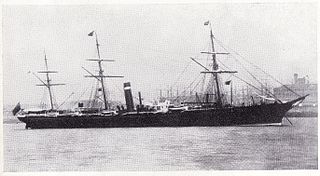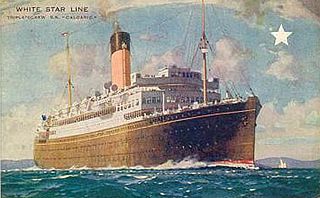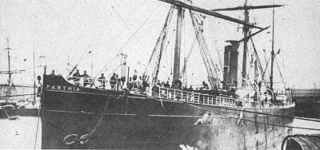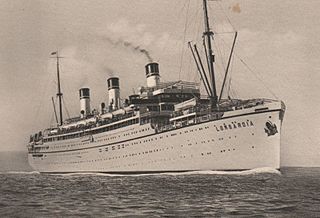
Cunard Line is a British shipping and cruise line based at Carnival House at Southampton, England, operated by Carnival UK and owned by Carnival Corporation & plc. Since 2011, Cunard and its three ships have been registered in Hamilton, Bermuda.

A steamship, often referred to as a steamer, is a type of steam-powered vessel, typically ocean-faring and seaworthy, that is propelled by one or more steam engines that typically move (turn) propellers or paddlewheels. The first steamships came into practical usage during the early 1800s; however, there were exceptions that came before. Steamships usually use the prefix designations of "PS" for paddle steamer or "SS" for screw steamer. As paddle steamers became less common, "SS" is assumed by many to stand for "steamship". Ships powered by internal combustion engines use a prefix such as "MV" for motor vessel, so it is not correct to use "SS" for most modern vessels.

SS Justicia was a British troop ship that was launched in Ireland in 1914 and sunk off County Donegal in 1918. She was designed and launched as the transatlantic liner Statendam, a new flagship for the Holland America Line (NASM), but the outbreak of First World War delayed her completion. In 1915 NASM agreed to let the United Kingdom acquire her and have her completed as a troop ship.

The Inman Line was one of the three largest 19th-century British passenger shipping companies on the North Atlantic, along with the White Star Line and Cunard Line. Founded in 1850, it was absorbed in 1893 into American Line. The firm's formal name for much of its history was the Liverpool, Philadelphia and New York Steamship Company, but it was also variously known as the Liverpool and Philadelphia Steamship Company, as Inman Steamship Company, Limited, and, in the last few years before absorption, as the Inman and International Steamship Company.

SS Servia, also known as RMS Servia, was a successful transatlantic passenger and mail steamer of revolutionary design, built by J & G Thomson of Clydebank and launched in 1881. She was the first large ocean liner to be built of steel instead of iron, and the first Cunard ship to have an electric lighting installation.

Lucania was a British ocean liner owned by the Cunard Steamship Line Shipping Company, built by Fairfield Shipbuilding and Engineering Company of Govan, Scotland, and launched on Thursday, 2 February 1893.

The Arizona was a record breaking British passenger liner that was the first of the Guion Line's Atlantic Greyhounds on the Liverpool-Queenstown-New York route. One nautical historian called Arizona "a souped up transatlantic hot rod." Entering service in 1879, she was the prototype for Atlantic express liners until the Inman Line introduced its twin screw City of New York in 1889. The Arizona type liner is generally considered as unsuccessful because too much was sacrificed for speed. Laid up in 1894 when Guion stopped sailings, Arizona was sold four years later and briefly employed in the Pacific until she was acquired by the US Government for service in the Spanish–American War. As the U.S. Navy's Hancock she continued trooping through W.W.I. and was finally scrapped in 1926.

City of Paris was a British passenger liner operated by the Inman Line that established that a ship driven by a screw could match the speed of the paddlers on the Atlantic crossing. Built by Tod and Macgregor, she served the Inman Line until 1884 when she was converted to a cargo ship.

City of Brussels was a British passenger liner that set the record for the fastest Atlantic eastbound voyage in 1869, becoming the first record breaker driven by a screw. Built by Tod and Macgregor, she served the Inman Line until 1883 when she sank with the loss of ten people after a collision while entering the Mersey.

Scotia was a British passenger liner operated by the Cunard Line that won the Blue Riband in 1863 for the fastest westbound transatlantic voyage. She was the last oceangoing paddle steamer, and as late as 1874 she made Cunard's second fastest voyage. Laid up in 1876, Scotia was converted to a twin-screw cable layer in 1879. She served in her new role for twenty-five years until she was wrecked off of Guam in March 1904.

Persia was a British passenger liner operated by the Cunard Line that won the Blue Riband in 1856 for the fastest westbound transatlantic voyage. She was the first Atlantic record breaker constructed of iron and was the largest ship in the world at the time of her launch. However, the inefficiencies of paddle wheel propulsion rendered Persia obsolete and she was taken out of service in 1868 after only twelve years. Attempts to convert Persia to sail were unsuccessful and the former pride of the British merchant marine was scrapped in 1872.

The Britannia class was the Cunard Line's initial fleet of wooden paddlers that established the first year round scheduled Atlantic steamship service in 1840. By 1845, steamships carried half of the transatlantic saloon passengers and Cunard dominated this trade. While the units of the Britannia class were solid performers, they were not superior to many of the other steamers being placed on the Atlantic at that time. What made the Britannia class successful is that it was the first homogeneous class of transatlantic steamships to provide a frequent and uniform service. Britannia, Acadia and Caledonia entered service in 1840 and Columbia in 1841 enabling Cunard to provide the dependable schedule of sailings required under his mail contracts with the Admiralty. It was these mail contracts that enabled Cunard to survive when all of his early competitors failed.

The North Coast Steam Navigation Company was a shipping company that operated in Australia, formed as the Grafton Steam Navigation Company in 1855. The company was later renamed the Clarence & Richmond River Steam Navigation Company before being renamed in December 1888 as the Clarence, Richmond & Macleay River Steam Navigation Company.

SS Calgaric was a steam ocean liner that was completed in 1917, assumes service in 1918 and scrapped in 1934. She was built for the Pacific SN Co Line as Orca. In 1923 she was transferred to the Royal Mail Line. In 1927 she was transferred to White Star Line and renamed Calgaric.

SS Parthia (1870–1956) was an iron-hulled transatlantic ocean liner built for the Cunard Line by William Denny and Brothers in Dumbarton, Scotland. Her sister ships were the Abyssinia and Algeria. Unlike her two sisters, Parthia was smaller, built in a different shipyard and had a slightly different funnel arrangement. The Parthia was retired by Cunard in 1883 and sold to John Elder & Co., who subsequently transferred her to the Guion Line. After serving with the Guion Line and operating on trans-Pacific routes with the Canadian Pacific Railway Company, she was refitted and renamed Victoria.
SS Aleppo was a British passenger cargo vessel, launched on 1 November 1864, measuring 292.5 feet by 38.2 feet, 2,057 gross tonnage, built in Glasgow by J & G Thomson, Govan. She made her first North Atlantic voyage from Liverpool to Halifax to New York City beginning on 15 September 1865. The Aleppo had accommodation for 46 first class and 593 third class passengers. The ship was commissioned for the British & Foreign Steam Navigation Company, Glasgow, a company established in 1855 to run the Mediterranean shipping interests of the investors of the British and North American Royal Mail Steam-Packet Company, the forerunner of the Cunard Line. In 1878 the firms were reorganised, the British & Foreign Steam Navigation Company and its ships were merged into the Cunard Steam Ship Co. Ltd., and Aleppo was transferred on 7 September 1878.

SS Madiana was a passenger and cargo steam ship designed and built in the Robert Napier and Sons shipyard in Glasgow in 1877 as SS Balmoral Castle. She was sold several times over the next 20 years, being named SS San Augustin between 1882 and 1886, before reverting to Balmoral Castle. She was finally sold to the Quebec S.S. Company, Ltd. in 1893 and was renamed Madiana.

SS Canonbar was a steam cargo ship built in Ardrossan, Scotland in 1910 for the North Coast Steam Navigation Company, and used in the Australian coastal trade. During World War II, she was part of the US supply fleet in the Pacific Ocean. From 1949, she was Rosita, until 1960, when she was renamed Valiente. Under the name Kettara IV, she was sunk by shell fire off the Vietnamese coast in 1966, with the loss of her entire crew.

SS Lombardia was one of a pair of transatlantic steam ocean liners that were launched in 1914 in Germany for the Hamburg America Line (HAPAG), sold to a Dutch shipping line in 1916, and seized by the United States as World War I reparations in 1922. United American Lines (UAL) operated her until 1926, when HAPAG bought her back.

RMS Gallia was built in 1878 for the Cunard Line, entering service in 1879. In service until 1899, the vessel ran aground off the coast of Quebec, Canada and was not repaired. The ship was broken up for scrap in 1900.
 Hecla at an unknown port. taken after her 1871 rebuild
Hecla at an unknown port. taken after her 1871 rebuild


















